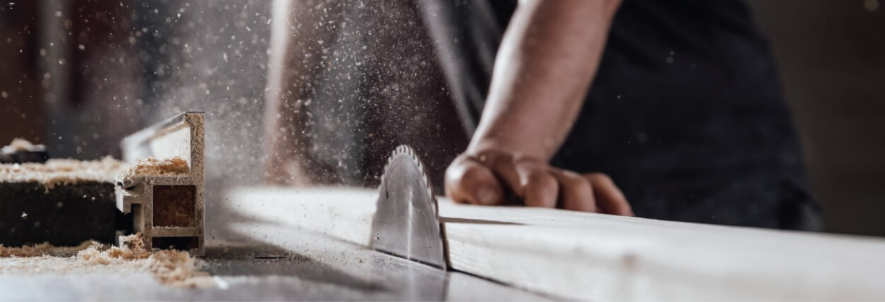
Employees in many occupations go to work every day with the full knowledge they will routinely be exposed to dust. In industries such as mining, carpentry, masonry, and manufacturing, among many others, workplace dust remains unavoidable. Although agencies such as the Occupational Health and Safety Administration (OSHA) mandate dust protection, workers and supervisors often misunderstand what constitutes a clear and present danger.
In too many sectors, decision-makers require people to wear dust protection gear only when certain types of dust have been identified as a risk. Obviously, asbestos ranks as the most feared. But airborne particles such as silica, have gained attention in recent years. The dust that doesn’t get the attention it sometimes deserves can negatively impact hard-working people's health and well-being. Only by understanding the types of dust that put people at risk, and wearing disposable protective clothing produced by companies such as International Enviroguard, can workers truly complete their shifts safely.
In too many sectors, decision-makers require people to wear dust protection gear only when certain types of dust have been identified as a risk. Obviously, asbestos ranks as the most feared. But airborne particles such as silica, have gained attention in recent years. The dust that doesn’t get the attention it sometimes deserves can negatively impact hard-working people's health and well-being. Only by understanding the types of dust that put people at risk, and wearing disposable protective clothing produced by companies such as International Enviroguard, can workers truly complete their shifts safely.
Common Types of Industrial Dust that Threaten Worker Health
Although shift supervisors typically react to seeing airborne dust particles, the finer and more difficult ones to identify often pose a greater risk. Many larger particles get filtered out by nose hairs. Mucous and saliva tend to capture noticeable particles as part of the body’s inherent dust protection system.
But the smaller particles may evade these natural barriers and make their way into the lungs. Miniscule toxic and combustible dust particles embed themselves in the lungs, eyes, ears and penetrate other organs. These common workplace types of dust require personal protective equipment in the workplace.
What Workers Need to Know About Organic Dust
It may come as something of a surprise, by dust created in agricultural settings put people at risk. This seems almost counterintuitive when we consider that farms produce the food and nourishment communities need. Although things such as hay, grain, and straw may be organic and otherwise healthy, the small particles of dust that fly into the air can become lodged in farm workers' lungs. These organic farm dust particles include the following.
- Molds
- Pollens
- Bacteria
- Pesticides & Chemicals
- Feed and Bedding Particles
- Animal Droppings
- Animal Hair and Feathers
People who work in the agricultural sector for prolonged periods without dust protection gear may develop Organic Dust Toxic Syndrome. This dust-related ailment presents with symptoms such as coughing, wheezing, high rates of infection, pneumonia, and bronchitis, among others. Approximately 10 percent of people who work in the industry develop flu-like symptoms from dust. Repeated exposure without protective equipment can result in Farmer’s Lung, a condition that results in highly allergic reactions to mold spores. Farmer’s Lung can lead to permanent lung damage and may prove fatal in some cases.
What Workers Need to Know About Chemical Dust
Perhaps the greatest threat to worker safety stems from chemical and combustible dust. Routinely encountered in manufacturing facilities, substantial overlap exists between what is considered chemical and combustible dust. That’s largely why the National Fire Protection Agency (NFPA) plays a critical role in assessing threats and establishing rules that OSHA generally adopts and enforces. These highly toxic chemical dust particles become airborne in environments in which the following processes occur.
- Chemicals Blended Together
- Products Coated with Chemicals
- Products Carried on Conveyor
- Materials Crushed, Milled, or Pelletized
During these operations and other manufacturing processes, liquid chemicals can be converted into dangerous vapors. Dry particles generally splinter off of products that are worked on, cut, crushed, or moved about. And metalworking facilities use high-heat gouging and welding tools that can splatter hot materials into the space, such as lead, iron oxide, and chromium, among others.
Workers should always be required to wear disposable protective clothing such as coveralls, gloves, headgear, and protective footwear, among other dust protection gear. These particles can attach to the skin causing severe burns and be inhaled into the lungs when effective personal protection equipment is not worn consistently.
What Workers Need to Know About Combustible Dust
The effects of coming into contact with chemical dust and splatter tend to get an immediate reaction from workers. Combustible dust, by contrast, lingers in the air, on clothing, or in collectors until it ignites or adversely impacts worker health. That’s why OSHA mandates companies to comply with its strict Permissible Exposure Limits (PEL) in the workplace. The PEL rate dictates the maximum allowable concentration of particles that an employee can be exposed to during a single, 8-hour shift. The following rank among the most common types of combustible dust in the workplace.
- Metal Materials such as Aluminum and Magnesium
- Sawdust in Lumber & Paper Mills
- Plastic Fibers and Additives
- Organic Materials such as Sugar, Flour, and Soap
- Dried Blood and Animal Parts from Slaughterhouses
- Rubber in Tire Manufacturing Plants
Any of these, and other fine dust particles, pose a unique danger to workers. Their presence in machinery, on floors, and in the air can result in a flash fire or explosion. Workers who do not have adequate combustible dust protection such as masks and protective clothing are at risk in the event of a plant fire or explosion.
How Does Combustible Dust Ignite
When OSHA instituted its Combustible Dust National Emphasis Program in 2007, a reported 1,000 inspections resulted in nearly 5,000 combustible dust violations. The agency doled out penalties of approximately $15 million. The agency also noted that only about 20 percent of facilities with combustible dust fully complied with OSHA regulations adopted from the NFPA standards.
Organizations such as the Chemical Safety Board, an independent body that investigates industrial incidents, purports that food processing facilities pose a heightened risk of combustible dust fires and explosions. Experts indicate that incidents remain preventable if the following conditions are identified and dealt with in a timely fashion.
- Sufficient Fine Combustible Dust Goes Airborne
- A Source of Ignition such as Flame, Spark, or Hot Surface is Present
- Sufficient Oxygen Present to Sustain a Flame or Combustion
- Dust Exists in Concentrations High Enough to Combust
- Combustible Dust Confined in a Space, Room, Ducts, or Equipment
Wide-reaching organic materials, metals, and others can fuel a flash fire or explosion under the right conditions. According to OSHA, administrative controls should be brought to eliminate hot work from being performed in at-risk areas. Engineering controls should be integrated to suppress flash fires or explosions and minimize their spread. But personal protective clothing must always be worn in facilities that produce combustible dust.
What Industries or Sectors Need Dust Protection?
The importance of worker safety and dust protection cannot be understated. But by that same token, certain industries remain at heightened risk of producing varieties of dust that create substantial health risks. Although it’s essential for workers in every sector to adorn disposable protective clothing whenever a health or safety risk presents itself, these are considered the sectors that require the most dust protection.
- Manufacturing: The manufacturing sector produces substantial dust throughout the vast majority of operations. These include loading docks movement, heavy equipment operations, fabrication, coating, and packaging, among others. Many manufacturing plants are tasked with collecting chemical and combustible dust.
- Food Processing: Organic dust ranks among the most combustible dust types. It also tends to be underappreciated in terms of its health and safety dangers.
- Lumber: Sawmills, paper plants, and other manufacturing operations that handle wood inherently create combustible dust. Workers would be well served to always adorn disposable protective clothing, masks, and googles, among other gear. Wood processing and manufacturing facilities are typically required to collect combustible dust.
- Painting and Coating: Advanced protective equipment must always be worn in workplaces that leverage harsh and flammable chemicals. These contaminants not only pose a severe burn hazard but can also quickly damage the lungs.
Which Facilities are Required to Have Dust Tested?
The growing awareness that dust presents a significant health and safety hazard prompted regulatory responses from outfits such as the NFPA and OSHA, among others. Before 2016, a variety of dust-related standards created inconsistent monitoring and mitigation efforts across industries. But in 2016, the NFPA moved to develop comprehensive guidance that brought wide-reaching sectors under one regulatory roof.
Called the Standard on the Fundamentals of Combustible Dust, this guidance requires every facility that manages or generates dust to conduct and submit a Dust Hazard Analysis report. This measure went into effect in Sept. 2020, and the report helps determine risk and mitigation steps.
Once the report has been assessed, companies must develop safeguards and improved dust-safety standards. Employees must be trained to understand the risk of dust exposure and combustion and take preventive measures such as wearing dust protection clothing. The NFPA requires the Dust Hazard Analysis to be performed by a qualified individual able to assess credible dust risks and imminent threats. The NFPA effectively tasks companies with proving that its dust is not combustible by undergoing a third-party inspection.
What is OSHA Maximum Dust Exposure Level
Detailed dust inspections remain a necessary aspect of the Dust Hazard Analysis. Some environments must deal with rising dust clouds as part of their ongoing manufacturing process. These rank among the easiest to detect, and workers typically wear protective equipment because of the obvious risk. But dust deposits on machinery and floors, among others, tend not to garner the same level of response from workers. And fine, difficult to see dust particles require inspectors to measure air quality and apply OSHA Standard 29 CFR. OSHA sets an air quality maximum limit under its Standard 29 CFR that considers the amount of respirable or inhalable dust present.
What PPE is Recommended for Protecting Workers from Dust Risks?
It’s essential that employees have access to necessary disposable protective equipment and clothing when working in environments that cause or kick-up dust. Breathable masks remain a standard PPE that should be worn regardless of whether workers can see dust or not. Similarly, OSHA usually mandates protective eyewear or goggles.
Although some sectorManufacturings require employees only to wear splash-resistant protective clothing when harmful chemicals are present, combustible dust creates a significant danger. Should a flash fire or explosion occur, the workers would be best protected by wearing products that are flame resistant such as International Enviroguard’s PyroGuard FR garments, or its PyroGuard CRFRTM garments that protect against particulates, chemicals, and flames.
The point is that dust protection should not necessarily be considered only equal to what the perceived risk appears. Few would think that agricultural dust could have life-threatening implications. And combustible dust in a sawmill or sugar processing facility doesn’t seem dangerous until it ignites. That’s why a complete inventory of disposable protective clothing should be available to workers at all times. International Enviroguard produces a complete line of dust protection and accessories, such as tacky floor mats, that exceed industry standards.
View all dust protection PPE, or browse our particulate protection products below:
Resources:
- https://www.ncbi.nlm.nih.gov/pmc/articles/PMC5981916/#:~:text=Many%20types%20of%20potentially%20pathogenic,Cladosporium%2C%20Penicillium%2C%20and%20Aspergillus
- https://ohsonline.com/articles/2020/05/01/frequently-asked-questions-about-controlling-dangerous-dusts.aspx
- https://www.osha.gov/SLTC/etools/eyeandface/ppe/dust.html
- http://hetiservices.com/combustible-dust-explosion-hazards-lurking-dangers-mitigation-measures-the-september-2020-compliance-deadline/#:~:text=OSHA%20has%20imposed%20a%20deadline,%E2%80%9Cqualified%E2%80%9D%20and%20experienced%20individual (combustible dust regulations)
- https://ec.europa.eu/taxation_customs/dds2/SAMANCTA/EN/Safety/Dust_EN.htm
- https://www.ehstoday.com/industrial-hygiene/article/21118633/dealing-with-dust-in-the-workplace
- https://www.osha.gov/combustible-dust
- https://www.osha.gov/SLTC/youth/agriculture/organicdust.html#:~:text=Organic%20dust%20comes%20from%20hay,hair%2C%20feathers%2C%20and%20droppings
